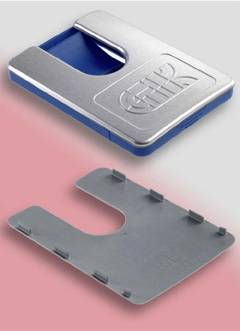May 4 2009
Injection moulds for a new back-moulding application - the direct back-moulding of metal foils - are now available from the company that develops and builds them: Georg Kaufmann Formenbau AG, Busslingen/Switzerland. This innovative technology combines the advantages and particular tactility of a metal surface with the functional and design versatility of a moulded plastic part: the metallic surface finishing process is now an integral and low-cost part of the injection moulding process.
 Business card holder as a sample part: the 0.2 mm thick aluminium foil
on the top, visible part of the holder was embossed with the logo during
the back-moulding operation; the reverse side of the top part is provided
with integrally moulded clips for attachment to the bottom part.
Photo: Georg Kaufmann Formenbau, Busslingen/ Switzerland
Business card holder as a sample part: the 0.2 mm thick aluminium foil
on the top, visible part of the holder was embossed with the logo during
the back-moulding operation; the reverse side of the top part is provided
with integrally moulded clips for attachment to the bottom part.
Photo: Georg Kaufmann Formenbau, Busslingen/ Switzerland
The metal foil is placed and held in the injection mould in much the same way as in any other back-moulding process for the surface decoration of moulded parts. With this new development, when processing metal foils of a thickness of up to approx. 0.3 mm, any surface structures machined into the walls of the cavity - e.g. logos and/or decorative elements - are transferred to the moulded part. While the mould is still closed after injection, the surplus foil is separated from the moulded part by means of an integrated punching tool. The punching tool operates in such a way that the cut edges of the foil wrap around the moulded part to produce a perfectly smooth edge without any overhang.
Typical metallic feel: "cool touch" effect Thanks to the high level of integration, the metal-foil back-moulding process can replace existing, cost-intensive processes that often have to be carried out in completely different locations. What is more, the direct back-moulding of metal foils offers advantages both in terms of application and in terms of quality. For example:
• the metal foil is thicker and less sensitive than a metallic layer applied by electroplating. It also has that typically cold metallic feel when you touch it ("cool touch" effect); • The bond between the metal foil and the plastic surface of the moulded part is both strong and permanent, while a subsequently fitted metal covering is heavier and has to be screwed or glued in place.
Besides aluminium and stainless steel foils, which have already proved to be ideal for this application, other foils are currently being tested for suitability. In order to ensure high dimensional stability and low warpage, the parts are mostly moulded in reinforced and/or filled thermoplastic materials. The coupling agent necessary for a reliable metal-plastic bond has been developed by the Hochschule für Technik in Rapperswil/Switzerland, with which Kaufmann works in close collaboration.